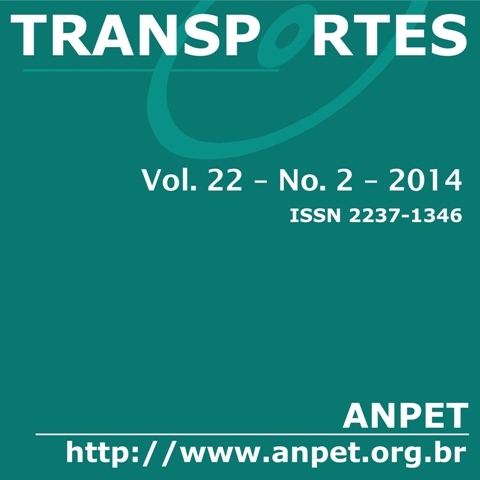Model prediction of the area of wear on road surfaces with coating surface treatment
DOI:
https://doi.org/10.14295/transportes.v22i2.763Keywords:
Asphalt pavements. Management systems. Performance models. Raveling.Abstract
This paper presents the development of a raveling prediction model for the highway network built in double surface treatmen in State of Bahia. Its starting point was a factorial design, based on information from a highway database provided by the Departamento de Infraestrutura de Transportes da Bahia (DERBA). The factors considered were the pavement age, traffic and rainfall. The Analysis of Variance was the technique used to analyze and assess the significant factors and define the parameters of the performance model. To verify the adequacy of the statistical model was used the straight fit to the observed data set, with determination of the correlation coefficient (r), residue analysis, and normal probability plot of the residuals. The model developed in this work showed fit to the data and a correlation coefficient r = 0.74.Downloads
References
American Society for Testing and Material (1996). ASTM E1777-996 (Reapproved 2002) – Standard Guide for Prioritization of Data Needs for Pavement Management. Philadelphia, USA, 09 p
Albuquerque, F. S. (2007) Sistema de gerência de pavimentos para departamentos de estradas do nordeste brasileiro. Tese (Doutorado). Universidade Federal do Rio Grande do Sul, Porto Alegre.
Benevides, S. A. S. (2006) Modelos de desempenho de pavimentos asfálticos para um sistema de gestão de rodovias estaduais do Ceará. Tese (Doutorado). COPPE, Universidade Federal do Rio de Janeiro, Rio de Janeiro.
Bennett, C. R.; Paterson, W. D. O. (2000) A guide to calibration and adaptation (Highway Development and Management - HDM-4). Birmingham, United Kingtom. Highway Development and Management Series, Version 1.0, v.5, 229p.
DERBA (2005) Sugestões Técnicas para Implementação do Programa de Restauração e Manutenção Rodoviária. v. 1a 5. Departamento de Infraestrutura de Transportes da Bahia. Salvador, BA.
GEIPOT (1981) Pesquisa Sobre o Inter-relacionamento dos Custos de Construção, Conservação e Utilização de Rodovias. Empresa Brasileira de Planejamento de Transportes, Ministério dos Transportes, Brasília, DF.
Hass, R.; Hudson, W. R.; Zaniewski, J. (1994) Modern pavement management. Flórida: Krieger Publishing Company, 581 p.
Marcon, F. M. (1996) Contribuição ao desenvolvimento de um sistema de gerência de pavimentos para a malha rodoviária estadual de Santa Catarina. Tese (Doutorado). Centro Técnico aeroespacial, Instituto Tecnológico de Aeronáutica, São Paulo.
Paterson, W. D. O. (1987) Road Deterioration and Maintenance Effects: Models for Planning and Management. Published for the Word Bank, Washington, D.C.
Paterson, W. D. O. (1989) A transferable causal model for predicting roughness progression in flexible pavements. Transportation Research Record, Washington, n. 1215, p. 70-84.
Queiroz, C. A. V. (1984) Modelos de previsão de desempenho para a gerência de pavimentos no Brasil. Brasília: GEIPOT, 366 p.
Queiroz, C. A. V (1981) Performance prediction models for pavement management in Brazil. Tese (Doutorado). The University of Texas at Austin, Texas.
Soncim, S. P.; Fernandes Jr., J. L. (2012) Desenvolvimento de um modelo de desempenho de irregularidade longitudinal para a rede de rodovias em tratamento superficial duplo do estado da Bahia. Transportes, Rio de Janeiro, v. 20, n. 1, p13-21.
Yshiba, J. K. (2003) Modelos de previsão de desempenho: estudos de rodovias do estado do Paraná. Tese (Doutorado). Escola de Engenharia de São Carlos, Universidade de São Paulo, São Paulo.
Watanada, T.; Paterson, W.; Bhandi, A.; Harral, C.; Dhareshwar, A. M. e Tsunokawa, K. (1987) The Highway Design and Maintenance Standards Model. v.1. Description of de HDM III model.
Downloads
Published
How to Cite
Issue
Section
License
Authors who submit papers for publication by TRANSPORTES agree to the following terms:
- The authors retain the copyright and grant Transportes the right of first publication of the manuscript, without any financial charge, and waive any other remuneration for its publication by ANPET.
- Upon publication by Transportes, the manuscript is automatically licensed under the Creative Commons License CC BY 4.0 license. This license permits the work to be shared with proper attribution to the authors and its original publication in this journal.
- Authors are authorized to enter into additional separate contracts for the non-exclusive distribution of the version of the manuscript published in this journal (e.g., publishing in an institutional repository or as a book chapter), with recognition of the initial publication in this journal, provided that such a contract does not imply an endorsement of the content of the manuscript or the new medium by ANPET.
- Authors are permitted and encouraged to publish and distribute their work online (e.g., in institutional repositories or on their personal websites) after the editorial process is complete. As Transportes provides open access to all published issues, authors are encouraged to use links to the DOI of their article in these cases.
- Authors guarantee that they have obtained the necessary authorization from their employers for the transfer of rights under this agreement, if these employers hold any copyright over the manuscript. Additionally, authors assume all responsibility for any copyright infringements by these employers, releasing ANPET and Transportes from any responsibility in this regard.
- Authors assume full responsibility for the content of the manuscript, including the necessary and appropriate authorizations for the disclosure of collected data and obtained results, releasing ANPET and Transportes from any responsibility in this regard.









